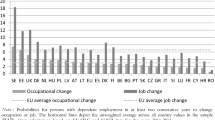Abstract
The Dutch labour market is characterized by low job mobility and high average duration of unemployment for older jobseekers. This study investigates the role of wage-tenure profiles in explaining patterns of job mobility. Based on a large administrative database, the estimates show that wage-tenure profiles in the Netherlands are relatively steep. Furthermore, industries with high returns to tenure appear to have a high share of older workers, as well as high average job tenure. This implies that steep wage-tenure profiles are related to low levels of mobility.
Similar content being viewed by others
References
Abraham K., Farber H. (1987) Job duration, seniority and earnings. American Economic Review 77(June): 278–297
Altonji, J. G., & Shakotko, R. (1987). Do wages rise with job seniority?. Review of Economic Studies, 54(3), 437--459.
Altonji J. G., Williams N. (2005) Do wages rise with job seniority? A reassessment. Industrial and Labour Relations Review 58(3): 370–397
Becker G. (1962) Investment in human capital: A theoretical analysis. Journal of Political Economy 70: 9–49
Ben-Porath, Y. (1967). The production of human capital and the life cycle of earnings. The Journal of Political Economy, 75(4, Part 1), 352--365.
Borghans, L., Cörvers, F., Kriechel, B., & Montizaan, R. (2007). Productiviteit, beloning en arbeidsmarktparticipatie van ouderen. Maastricht: ROA-report ROA-R-2007/5.
Buchinsky M., Fougére D., Kramarz F., Tchernis R. (2010) Interfirm mobility, wages, and the returns to seniority and experience in the US. The Review of Economic Studies 77: 972–1001
Buhai, S., Portela, M., Teulings, C., & Van Vuuren, A. (2008). Returns to tenure or seniority? IZA working paper no. 3302. Bonn, IZA.
Burdett K. (1978) A theory of employee job search and quit rates. American Economic Review 68: 212–220
Burdett K., Coles M. G. (2003) Equilibrium wage/tenure contracts. Econometrica 71(5 (Sept.)): 1377–1404
De Grip, A., Van Loo, J. (2002). The economics of skills obsolescence: A review. In A. de Grip, J. van Loo, K. Mayhew (Eds.) The economics of skills obsolescence (Research in Labor Economics, Vol. 21, pp. 1–26). Emerald Group Publishing Limited.
Dostie, B. (2011). Wages, productivity and aging. De Economist, 159(2), 139--158.
Dustmann C., Meghir C. (2005) Wages, experience and seniority. Review of Economic Studies 72: 77–108
Grout P. A. (1984) Investments and wages in the absence of binding contracts: a Nash bargaining approach. Econometrica 52(2): 449–460
Hosios A. J. (1990) On the efficiency of matching and related models of search and unemployment. Review of Economic Studies 57: 279–298
Jovanovic B. (1979) Job matching and the theory of turnover. Journal of Political Economy 87(5): 972–990
Kotlikoff L. J., Gokhale J. (1992) Estimating a firm’s age-productivity profile using the present value of workers’ earnings. Quarterly Journal of Economics 107: 1215–1242
Kuhn P., Robert J. (1989) Seniority and distribution in a two-worker trade union. The Quarterly Journal of Economics 104(3): 485–505
Lazear E. P. (1981) Agency, earnings profiles, productivity, and hours restrictions. American Economic Review 71: 606–620
Lefranc, A. (2003). Labor market dynamics and wage losses of displaced workers in France and the United States. William Davidson Institute working paper 614.
Lindbeck, A., & Snower, D. (1991). Interactions between the efficiency wage and insideroutsider theories. Economics Letters, 37(2), 193–196.
Medoff J. L., Abraham K. G. (1981) Are those paid more really more productive? The case of experience. Journal of Human Resources 16: 186–216
OECD (2006). Live longer, work longer. Paris: OECD Publishing.
Topel, R. H. (1991). Specific capital, mobility, and wages: Wages rise with job seniority. Journal of Political Economy, 99(1), 145--176.
Topel, R. H., & Ward, M. P. (1988). Job mobility and the careers of young men. Quarterly Journal of Economics, 107(May 1992), 441–479.
Ter Weel, B., Van der Horst, A., & Gelauff, G. (2010). The Netherlands in 2040. The Hague: CPB Special Publication 88.
van Ours C., Stoeldraijer L. (2011) Age, wage and productivity in Dutch manufacturing. De Economist 159: 113–137
Williams N. (2009) Seniority, experience and wages in the UK. Labour Economics 16(3): 272–283
Zwick, T. (2008). The employment consequences of seniority wages. ZEW Discussion Paper No. 08-039. Mannheim.
Author information
Authors and Affiliations
Corresponding author
Rights and permissions
About this article
Cite this article
Deelen, A.P. Wage-Tenure Profiles and Mobility. De Economist 160, 141–155 (2012). https://doi.org/10.1007/s10645-011-9183-4
Published:
Issue Date:
DOI: https://doi.org/10.1007/s10645-011-9183-4




